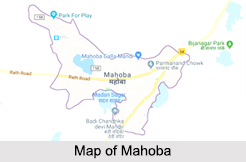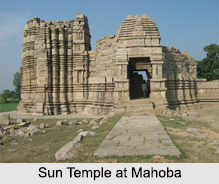 Mahoba is a city located in the Indian state of Uttar Pradesh. This city is 140 km from Jhansi and is associated with the Chandela Kings who ruled over Bundelkhand between the 9th and the 11th centuries. The name "Mahoba" is derived from Mahotsav Nagar, the city of great festivals. At the end of the 12th century, there was a kingdom of King Parmar in Mahoba. Prithviraj Chauhan had fought in the famous war of 1182 AD, in which the two brothers of Alha-Udal fought on the side of the Chandelas, had been stripped of Mahoba Parmal, but after some time the Chandelas again got power over it.
Mahoba is a city located in the Indian state of Uttar Pradesh. This city is 140 km from Jhansi and is associated with the Chandela Kings who ruled over Bundelkhand between the 9th and the 11th centuries. The name "Mahoba" is derived from Mahotsav Nagar, the city of great festivals. At the end of the 12th century, there was a kingdom of King Parmar in Mahoba. Prithviraj Chauhan had fought in the famous war of 1182 AD, in which the two brothers of Alha-Udal fought on the side of the Chandelas, had been stripped of Mahoba Parmal, but after some time the Chandelas again got power over it.
At Mahoba, the impregnable hilltop fort and the lakes they created are considered engineering feats and their water management systems can still be seen. Mahoba was also a great cultural centre. Ballads praise its days of glory and narrate the inspiring saga of Alha and Udal, two brothers who sacrificed their lives for the honour of their land.
Demography of Mahoba
As of 2011 India census, Mahoba has a population of 95,216. Mahoba has an average literacy rate of 74.91 per cent, higher than the state average of 67.68 per cent. The male literacy is 82.03 per cent and female literacy is 66.88 per cent with 12.68 per cent of the population under 6 years of age.
Schedule Caste and Schedule Tribe constitute 14.93 per cent and 0.42 per cent of the total population in Mahoba. Based on the census 75.21 per cent of the total population are Hindus, 23.64 per cent are Muslims and the rest is occupied by other faiths.
 Places of Interest at Mahoba
Places of Interest at Mahoba
There are many places of historical and archaeological interest as well as scenic lakes dotted with rocky islets in Mahoba. The temples of Mahoba are built in the same style as the Khajuraho temples. Some of the places of interest at Mahoba are as follows:
Kakramath Temple: This temple is well-preserved granite which is dedicated to Lord Shiva and is located at the Madan Sagar. Its basic plan is similar to the temples of Khajuraho. The Madan Temple dedicated to Lord Vishnu stands nearby.
Vijay Sagar Pakshi Vihar: Vijay Sagar Pakshi Vihar is located at 5 km from town. This is a picturesque bird sanctuary that has been developed on the shores of Vijay-Sagar, which was built by Vijay Pal Chandela (1035-1060 AD).
Sun Temple at Rahila Sagar: This 9th century granite Sun Temple lies to the west of Rahila Sagar, built by Chandela ruler Rahila who ruled between 890 and 910 AD. Though, today this temple is in a ruined state, it still stands as the premium example of early Pratihara architecture in the area.
Manaiya Devi Temple: This is the temple of the tutelary deity of the Chandelas and stands on the shores of Madan Sagar, near the fort. In front of it is monolithic granite pillar, 18 ft. high and 1.75 ft wide at the base. The shrine of Pir Mubarak Shah, a Muslim saint who came from Arabia in 1252 AD, is nearby
Lakes in Mahoba: Kirat Sagar, built by Kirtivarman between 1060 AD and 1100 AD, has fine embankments with granite steps. Madan Sagar, built by Madanvarman between 1128 AD and 1165 AD, is very picturesque. Other lakes include Kalyan Sagar, Vijay Sagar and Rahila Sagar.
Gokhar Hill: This is the hill where Guru Gorakhnath resided with his disciples. It has dramatic granite rock formations, with caves and waterfalls. The spot is ideal for climbing and picnics.
Other places of interest at Mahoba include the Jain and Buddhist shrines, the Alha Udal Chowk, Barichandrika Devi Temple, Ram Kurd, Suraj Kurd and Shiva Temple at Katheswar. Today, the town is known for its fine betel leaf cultivation and granite rocks.



















